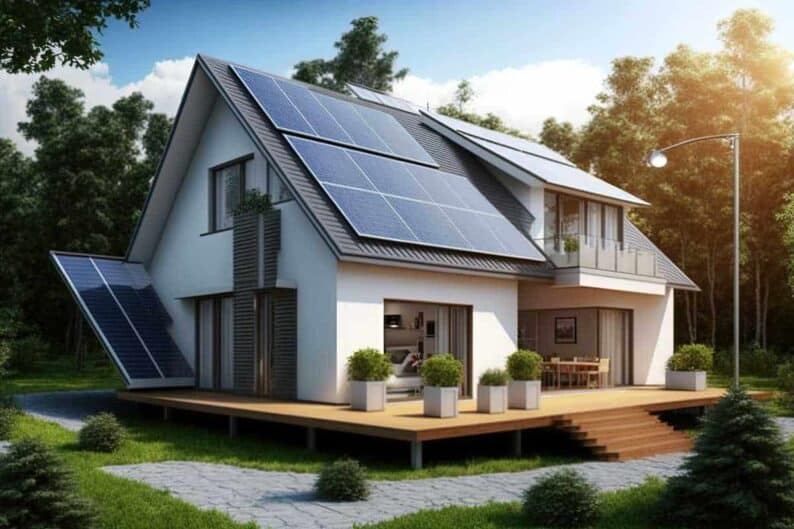In the current era, where environmental concerns are at the forefront of global discourse, the concept of eco-friendly living has become increasingly significant.
This shift towards sustainability is evident in the realm of home improvements, where more and more homeowners are considering eco-friendly renovations. However, a common barrier to undertaking such projects is the concern over costs. The expenses associated with home renovations can vary widely, influenced by factors such as the type of project, its scope, the materials used, and specific environmental considerations.
To put this into perspective, let’s consider the example of bathroom remodeling in Jacksonville. The costs here can range from as low as $6,270 to as high as $38,990. This wide range indicates that eco-friendly renovations can be tailored to fit various budgets, depending on the choices homeowners make in terms of materials, design, and scale of the project. It underscores the idea that sustainable living doesn’t always have to come with a hefty price tag.
Eco-Friendly Bathroom Upgrades
One of the most impactful areas for eco-friendly renovations in a home is the bathroom. Sustainable bathroom upgrades not only contribute to environmental conservation but also offer long-term cost savings through efficient use of resources. One key aspect of such upgrades is the selection of sustainable materials. These include recycled or sustainably sourced tiles, low-VOC (Volatile Organic Compounds) paints, and eco-friendly cabinetry. These materials are not only better for the environment but also healthier for the home’s inhabitants.
Another significant upgrade is the incorporation of water conservation methods. Installing low-flow toilets and shower heads can significantly reduce water usage without sacrificing performance. These fixtures are designed to use less water per flush or minute, leading to substantial savings on water bills over time. For those living in Jacksonville, consulting a Jacksonville bathroom remodeling company can be beneficial. These companies often have expertise in sustainable bathroom solutions, offering products and designs that cater to eco-friendly living while keeping in mind the local climate and water usage norms.
Solar Panel Installation
Solar panel installation is a cornerstone of eco-friendly home improvements. Transitioning to solar energy not only helps in reducing the household’s carbon footprint but also results in considerable savings on electricity bills. Solar panels capture renewable energy from the sun, converting it into electricity that can power your home. This switch to a renewable energy source reduces reliance on fossil fuels and contributes to a cleaner environment.
The installation of solar panels involves an initial investment, but the long-term benefits are substantial. Besides reducing electricity costs, solar panels can increase the value of a home. Additionally, many governments offer incentives, rebates, or tax breaks for solar panel installation, making it more accessible to homeowners. These incentives not only help with the upfront costs but also promote sustainable practices at a community level.
Energy-Efficient Windows and Insulation
Improving a home’s energy efficiency is another key area in eco-friendly renovations, and this can be significantly achieved through the installation of energy-efficient windows and proper insulation. Energy-efficient windows are designed to prevent heat loss during colder months and keep the interior cool during warmer months. It means less reliance on heating and air conditioning, leading to lower energy consumption and reduced utility bills.
When it comes to insulation, choosing the right materials is crucial. Eco-friendly options include cellulose, wool, and certain types of foam insulation that are not only effective in maintaining temperature but are also made from recycled or sustainable materials. These insulation help in minimizing the environmental impact of the home while ensuring that it remains comfortable throughout the year.
Together, energy-efficient windows and effective insulation form a powerful combination in reducing a home’s overall energy footprint. They make the home more comfortable, reduce noise pollution, and contribute to a healthier living environment, all while supporting the broader goal of environmental sustainability.
Smart Home Systems for Energy Management
Incorporating smart home systems is an innovative way to enhance eco-friendly living. These systems consist of interconnected devices that can be controlled remotely, often via a smartphone app, allowing for optimal energy management. A key component is the smart thermostat, which adjusts the heating and cooling of your home based on your habits and preferences, ensuring energy is not wasted when the home is unoccupied. This adjustment not only makes life more convenient but significantly reduces energy consumption.
Smart lighting is another aspect of these systems. LED lights can be scheduled to turn off when not needed, and their brightness can be adjusted according to the time of day or specific requirements, further conserving energy. Additionally, smart energy monitors give homeowners real-time insights into their energy usage, enabling them to make informed decisions about their consumption habits. These smart systems are not just about technological advancement; they represent a shift towards a more conscious and sustainable way of living.
Rainwater Harvesting Systems
Rainwater harvesting systems are an excellent way to promote eco-friendly living by conserving water. These systems collect rainwater from roofs, which can then be stored and used for various purposes, such as watering gardens, flushing toilets, and even for laundry, depending on local regulations and purification methods. It not only reduces reliance on municipal water supplies but also decreases water bills.
The basic components of a rainwater harvesting system include gutters, filters, storage tanks, and distribution systems. Gutters catch the rainwater, which is then filtered to remove debris before being stored in tanks. For those interested in more advanced systems, there are options with purification features that make the water suitable for more domestic uses. Installing a rainwater harvesting system is a practical step towards sustainable living, particularly in areas prone to drought or where water conservation is a priority.
Sustainable Landscaping
Sustainable landscaping is about creating an outdoor space that is not only aesthetically pleasing but also environmentally friendly, which involves using native plants that are adapted to the local climate and require less water and maintenance. These plants often provide essential habitats for local wildlife, promoting biodiversity. Sustainable landscaping also includes practices like mulching, which helps retain soil moisture and reduces the need for watering.
Another key element of sustainable landscaping is the use of organic pest control methods instead of chemical pesticides, which can be harmful to the environment. Additionally, techniques such as xeriscaping (landscaping designed to limit or eliminate the need for irrigation) and the installation of drip irrigation systems can significantly reduce water usage. By implementing these practices, homeowners can create a beautiful outdoor space that is in harmony with the environment, supports local ecosystems, and is more cost-effective to maintain.
Conclusion
Eco-friendly home improvements are not just about reducing the environmental impact of our living spaces; they are also about creating healthier, more sustainable, and cost-effective homes. From upgrading to sustainable bathroom fixtures and solar panels to installing smart home systems and practicing sustainable landscaping, each step contributes to a greener future. These improvements not only align with environmental conservation efforts but also offer long-term financial benefits, making them a wise choice for homeowners looking to make a positive impact.












